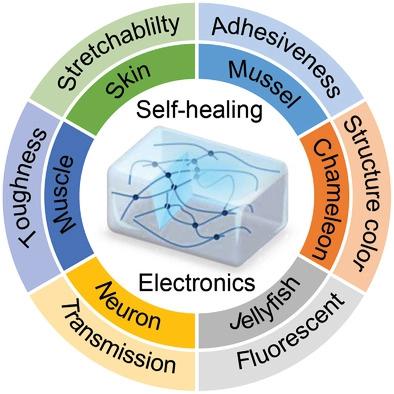当前位置:
X-MOL 学术
›
Adv. Funct. Mater.
›
论文详情
Our official English website, www.x-mol.net, welcomes your
feedback! (Note: you will need to create a separate account there.)
Bioinspired Self-healing Soft Electronics
Advanced Functional Materials ( IF 18.5 ) Pub Date : 2023-02-07 , DOI: 10.1002/adfm.202214479 Miao Qi 1, 2 , Ruiqi Yang 1, 3 , Zhe Wang 4 , Yanting Liu 4 , Qichong Zhang 5 , Bing He 4 , Kaiwei Li 6 , Qing Yang 1 , Lei Wei 4 , Caofeng Pan 3 , Mengxiao Chen 1, 2
Advanced Functional Materials ( IF 18.5 ) Pub Date : 2023-02-07 , DOI: 10.1002/adfm.202214479 Miao Qi 1, 2 , Ruiqi Yang 1, 3 , Zhe Wang 4 , Yanting Liu 4 , Qichong Zhang 5 , Bing He 4 , Kaiwei Li 6 , Qing Yang 1 , Lei Wei 4 , Caofeng Pan 3 , Mengxiao Chen 1, 2
Affiliation

|
Inspired by nature, various self-healing materials that can recover their physical properties after external damage have been developed. Recently, self-healing materials have been widely used in electronic devices for improving durability and protecting the devices from failure during operation. Moreover, self-healing materials can integrate many other intriguing properties of biological systems, such as stretchability, mechanical toughness, adhesion, and structural coloration, providing additional fascinating experiences. All of these inspirations have attracted extensive research on bioinspired self-healing soft electronics. This review presents a detailed discussion on bioinspired self-healing soft electronics. Firstly, two main healing mechanisms are introduced. Then, four categories of self-healing materials in soft electronics, including insulators, semiconductors, electronic conductors, and ionic conductors, are reviewed, and their functions, working principles, and applications are summarized. Finally, human-inspired self-healing materials and animal-inspired self-healing materials as well as their applications, such as organic field-effect transistors (OFETs), pressure sensors, strain sensors, chemical sensors, triboelectric nanogenerators (TENGs), and soft actuators, are introduced. This cutting-edge and promising field is believed to stimulate more excellent cross-discipline works in material science, flexible electronics, and novel sensors, accelerating the development of applications in human motion monitoring, environmental sensing, information transmission, etc.
中文翻译:

仿生自愈软电子
受自然界的启发,人们开发了各种可以在外部损伤后恢复物理性能的自修复材料。最近,自修复材料已广泛用于电子设备中,以提高耐用性并保护设备在运行过程中免受故障影响。此外,自修复材料可以整合生物系统的许多其他有趣特性,例如可拉伸性、机械韧性、粘附性和结构着色,提供额外的迷人体验。所有这些灵感都吸引了对仿生自愈软电子产品的广泛研究。这篇综述详细讨论了仿生自愈软电子产品。首先,介绍两种主要的愈合机制。那么,软电子中的四大类自愈材料,包括绝缘体、半导体、电子导体和离子导体,综述了它们的功能、工作原理和应用。最后,人类自愈材料和动物自愈材料及其应用,如有机场效应晶体管 (OFET)、压力传感器、应变传感器、化学传感器、摩擦纳米发电机 (TENG) 和软执行器,被引入。这一前沿和前景广阔的领域有望激发出更多材料科学、柔性电子、新型传感器等领域的优秀交叉学科成果,加速其在人体运动监测、环境传感、信息传输等领域的应用发展。并总结了它们的作用、工作原理和应用。最后,人类自愈材料和动物自愈材料及其应用,如有机场效应晶体管 (OFET)、压力传感器、应变传感器、化学传感器、摩擦纳米发电机 (TENG) 和软执行器,被引入。这一前沿和前景广阔的领域有望激发出更多材料科学、柔性电子、新型传感器等领域的优秀交叉学科成果,加速其在人体运动监测、环境传感、信息传输等领域的应用发展。并总结了它们的作用、工作原理和应用。最后,人类自愈材料和动物自愈材料及其应用,如有机场效应晶体管 (OFET)、压力传感器、应变传感器、化学传感器、摩擦纳米发电机 (TENG) 和软执行器,被引入。这一前沿和前景广阔的领域有望激发出更多材料科学、柔性电子、新型传感器等领域的优秀交叉学科成果,加速其在人体运动监测、环境传感、信息传输等领域的应用发展。介绍了有机场效应晶体管 (OFET)、压力传感器、应变传感器、化学传感器、摩擦纳米发电机 (TENG) 和软致动器等。这一前沿和前景广阔的领域有望激发出更多材料科学、柔性电子、新型传感器等领域的优秀交叉学科成果,加速其在人体运动监测、环境传感、信息传输等领域的应用发展。介绍了有机场效应晶体管 (OFET)、压力传感器、应变传感器、化学传感器、摩擦纳米发电机 (TENG) 和软致动器等。这一前沿和前景广阔的领域有望激发出更多材料科学、柔性电子、新型传感器等领域的优秀交叉学科成果,加速其在人体运动监测、环境传感、信息传输等领域的应用发展。
更新日期:2023-02-07
中文翻译:

仿生自愈软电子
受自然界的启发,人们开发了各种可以在外部损伤后恢复物理性能的自修复材料。最近,自修复材料已广泛用于电子设备中,以提高耐用性并保护设备在运行过程中免受故障影响。此外,自修复材料可以整合生物系统的许多其他有趣特性,例如可拉伸性、机械韧性、粘附性和结构着色,提供额外的迷人体验。所有这些灵感都吸引了对仿生自愈软电子产品的广泛研究。这篇综述详细讨论了仿生自愈软电子产品。首先,介绍两种主要的愈合机制。那么,软电子中的四大类自愈材料,包括绝缘体、半导体、电子导体和离子导体,综述了它们的功能、工作原理和应用。最后,人类自愈材料和动物自愈材料及其应用,如有机场效应晶体管 (OFET)、压力传感器、应变传感器、化学传感器、摩擦纳米发电机 (TENG) 和软执行器,被引入。这一前沿和前景广阔的领域有望激发出更多材料科学、柔性电子、新型传感器等领域的优秀交叉学科成果,加速其在人体运动监测、环境传感、信息传输等领域的应用发展。并总结了它们的作用、工作原理和应用。最后,人类自愈材料和动物自愈材料及其应用,如有机场效应晶体管 (OFET)、压力传感器、应变传感器、化学传感器、摩擦纳米发电机 (TENG) 和软执行器,被引入。这一前沿和前景广阔的领域有望激发出更多材料科学、柔性电子、新型传感器等领域的优秀交叉学科成果,加速其在人体运动监测、环境传感、信息传输等领域的应用发展。并总结了它们的作用、工作原理和应用。最后,人类自愈材料和动物自愈材料及其应用,如有机场效应晶体管 (OFET)、压力传感器、应变传感器、化学传感器、摩擦纳米发电机 (TENG) 和软执行器,被引入。这一前沿和前景广阔的领域有望激发出更多材料科学、柔性电子、新型传感器等领域的优秀交叉学科成果,加速其在人体运动监测、环境传感、信息传输等领域的应用发展。介绍了有机场效应晶体管 (OFET)、压力传感器、应变传感器、化学传感器、摩擦纳米发电机 (TENG) 和软致动器等。这一前沿和前景广阔的领域有望激发出更多材料科学、柔性电子、新型传感器等领域的优秀交叉学科成果,加速其在人体运动监测、环境传感、信息传输等领域的应用发展。介绍了有机场效应晶体管 (OFET)、压力传感器、应变传感器、化学传感器、摩擦纳米发电机 (TENG) 和软致动器等。这一前沿和前景广阔的领域有望激发出更多材料科学、柔性电子、新型传感器等领域的优秀交叉学科成果,加速其在人体运动监测、环境传感、信息传输等领域的应用发展。











































 京公网安备 11010802027423号
京公网安备 11010802027423号